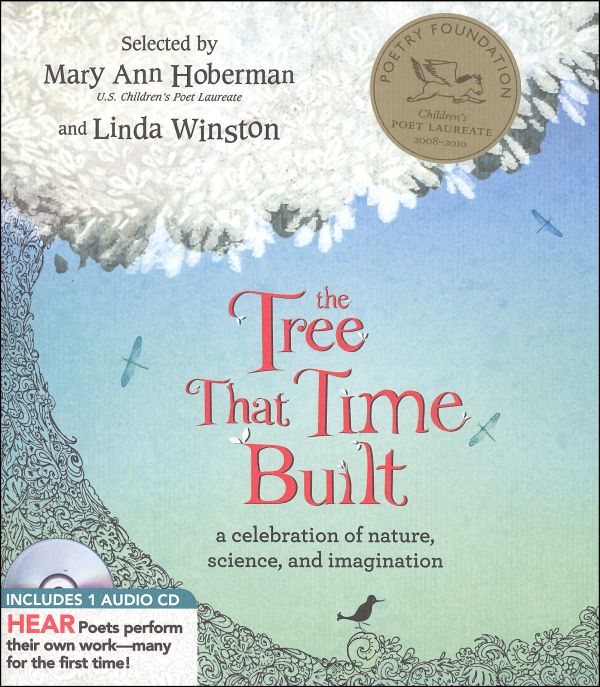
BIBLIOGRAPHY
Hoberman, Mary A., and Linda Winston (editors). The Tree That Time Built. Naperville, IL: Sourcebooks Jabberwocky, 2009. ISBN 9781402225178
PLOT SUMMARY
Science and poetry are more alike than we might think. That’s what a children’s poet laureate–schoolteacher duo are out to prove in a book dedicated to the greatest naturalist of all time—Charles Darwin. This compilation of over 100 poems by more than 70 poets is divided into nine sections honoring topics such as the sea, the trees, prehistoric life, reptiles, and our role in taking care of the planet. Classic poets like Ralph Waldo Emerson, William Blake, Emily Dickinson, and Ogden Nash make an appearance. Yet the duo is also careful to select poems from modern award-winners like Joseph Bruchac, Douglas Florian, Kristine O’Connell George, and Tony Johnston, as well as lesser-known writers. Poems are sometimes accompanied by minimalistic art and brief comments or questions for the reader to ponder. The back of the book includes a glossary, suggestions for further reading, and short summaries of each poet.
CRITICAL ANALYSIS
The organization in The Tree That Time Built is well done and the design is clean and clear. Each section is marked with a thoughtful introduction and a breathtaking tree illustration. Teachers, parents, and middle-graders need look no further for a poetry collection that bridges the gap between juvenile and adult poetry. The book includes not only oral readings of many of the poems, but also a helpful glossary, poet bibliography, and additional resources for further naturalistic and poetic study. And, with questions reflecting on what the world would be like without trees or what would happen if we lost our connection to the natural world, the book prompts thoughtful middle-graders to think more deeply, helping them to gain important analytical skills and a deeper appreciation for poetry, science, and the connections we share with all living things.
Furthermore, poems run the emotional gamut. Some are funny like “The Jellyfish and the Clam”—one “‘no more than a lump of wet squish,’” the other “‘just a thick shell.’” Some are philosophical like “If They Spoke,” a poem in which Mark Van Doren wonders what animals would tell us if they could talk. Some are comforting like “The Sea is Our Mother,” and others melancholy like “Nothing Gold Can Stay.” In a truly incredible display of their selection powers, Hoberman and Winston have successfully balanced an enormous variety of poetical voices, no one outtalking the others.
One especially captivating poem is an excerpt from March ’79, translated from its original Swedish. The translator writes, “I come across the marks of roe-deer’s hooves in the snow. / Language but no words.” Here, readers uncover an original and wholly surprising insight—that animal tracks tell a story. As delightful as this poem was to read, even more delightful is the fact that each and every poem has its own insight to ponder. In this collection, there are no duds.
AWARDS AND REVIEW EXCERPTS
Cybils Award Nominee for Poetry (2009)
From Publisher’s Weekly: “Taken in total, the poems encompass nature’s multitudinous qualities, from harsher realities (‘On my early walk/ I passed the Frog Prince/ dead in a rut of the road,’ in Virginia Hamilton Adair’s Early Walk) to its ability to inspire at its most microscopic, as Ralph Waldo Emerson writes, ‘Atom from atom yawns as far/ As moon from earth,/ as star from star.’”
From Booklist: “Selected by Winston, an anthropologist and teacher, and Hoberman, the current U.S. Children’s Poet Laureate, this attractive, accessible anthology collects poems that celebrate both the facts and the mysteries of the natural world.”
From Library Media Connection: “Children’s Poet Laureate Mary Ann Hoberman gives us an exciting collection of over 100 poems that make connections between poetry and science. . . . This collection would be a great choice to use as a collaborative tool with Middle School Science and English classes.”
From School Library Journal: “From the playful to the profound, the poems invite reflection and inspire further investigation.”
CONNECTIONS
- Ask middle-schoolers to pick one favorite poem from the collection and memorize it. Then have a recitation party together.
- Focus on one of the poems from the collection that includes commentary from Hoberman and Winston. Talk through their commentary and discussion prompt together.
- Listen to one section of the poetry collection audio CD together while middle-schoolers create a piece of artwork that relates to that poetry section. Then, put on an art show and allow them to present their work.
- After reading The Tree That Time Built, read through some of the poet biographies in the back of the book and present children with these poets’ other works. The following books could be possible candidates:
- Hoberman, Mary A., and Betty Fraser (illustrator). The Llama Who Had No Pajama: 100 Favorite Poems. ISBN 9780152055714
- Prelutsky, Jack, and James Stevenson (illustrator). The New Kid on the Block. ISBN 9780688022716
- Sidman, Joyce, and Beth Krommes (illustrator). Swirl by Swirl: Spirals in Nature. ISBN 9780547315836
- Singer, Marilyn, and Josée Masse (illustrator). Mirror Mirror: A Book of Reverso Poems. ISBN 9780525479017
*Note—This book review was created as an assignment for a course at Texas Woman’s University.